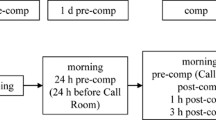Summary
The aim of this study was to investigate the seasonal behaviour of the plasma free testosterone: cortisol ratio (FTCR) and to relate hormonal changes to daily training volume and performance parameters on a rowing ergometer in elite female rowers. During 9 months of training preceding the 1988 Olympic Games the resting values of the FTCR in six elite female rowers were regularly (ten times) studied. Daily training volume was analysed in terms of rowed distance (l rowad) and time (t). In addition, two performance parameters, the power at 4.0 mmol·l−1 lactate concentration in the blood and the maximal power, were determined by a test on a rowing ergometer. The results indicated that the mean FTCR test value did not differ significantly from the level of the initial test or from the mean value of the directly preceding test. A significant negative correlation (r=−0.98, P<0.01) between FTCR and l rowed was found in a period i.e. at a training camp, when there was a sudden increase in training volume. When FTCR was related to t a significant positive correlation (r=0.88, P<0.05) was found only for the period at the training camp. Our data further suggested that the FTCR alone was not an adequate indicator for the anabolic/catabolic balance in elite female rowers. This finding was contrary to previous findings in elite male rowers. However, in training practice the FTCR seems useful as an indicator of the hormonal training status of elite female rowers when complemented with data about total and free testosterone, performance parameters and knowledge concerning cyclic variations of the FTCR.
Similar content being viewed by others
References
Adlercreutz H, Härkonen M, Kuoppasalmi K, Näveri H, Huhtaniemi H, Tikkanen H, Remes K, Dessypris A, Karvonen J (1986) Effect of training on plasma anabolic and catabolic steroid hormones and their responses during physical exercise. Int J Sports Med 7 [Suppl]:27–28
Bonen A (1983) Exercise-related disturbances in the menstrual cycle. In: Borer K, Edington D, White T (eds) Frontiers of exercise biology. Human Kinetics, Champaign, Ill., pp 214–237
Busso T, Häkkinen K, Pakarinen A, Carasso C, Lacour JR, Komi PV, Kauhanen H (1990) A systems model of training responses and its relationship to hormonal responses in elite weightlifters. Eur J Appl Physiol 61:48–54
Dressendorfer R, Wade C, Scaff J (1985) Increased morning heart rate in runners: a valid sign of overtraining? Phys Sports Med 13:77–86
Durnin J, Womersley J (1974) Body fat assessed from total body density and its estimation from skinfold thickness. Br J Nutr 32:77–97
Häkkinen K, Pakarinen A, Alén M, Komi P (1985) Serum hormones during prolonged training of neuromuscular performance. Eur J Appl Physiol 53:287–293
Häkkinen K, Pakarinen A, Alén M, Kauhanen H, Komi P (1988) Daily hormonal and neuromuscular responses to intensive strength training in 1 week. Int J Sports Med 9:422–428
Häkkinen K, Pakarinen A, Kyrolainen H, Cheng S, Kim D, Komi P (1990) Neuromuscular adaptations and serum hormones in females during prolonged power training. Int J Sports Med 11:91–98
Härkonen N, Kuoppasalmi K, Naveri H, Tikkanen H, Icen A, Adlercreutz H, Karvonen J (1984) Biochemical indicators in diagnosis of overstrain condition in athletes. Sports Med Exerc Sci Proceedings of Olympic Scientific Congress. Eugene, Oregon, USA. Available from the American Olympic Committee
Israel S (1958) Die Erscheinungsform des Obertrainings. Sportmedizin 8:207–215
Keizer H, Doorfman J, Bunnik G (1982) Influence of physical exercise on sex hormone metabolism. Med Sci Sports Exerc 48:765–769
Krieger D (ed) (1978) Endocrine rhythms. Comprehensive endocrinology series, Raven Press, New York
Kuipers H, Keizer H (1988) Overtraining in elite athletes, Review and directions for the future. Sports Med 6:79–92
Landeghem A van (1981) Plasma concentration gradient of steroid hormones across human mammary tumors in vivo. J Steroid Biochem 14:741
Murphy A, Cropp C, Smith B, Burkman R, Zacur H (1990) Effect of low-dose oral contraceptive on gonadotropins, androgens, and sex-hormone-binding-globuline in nonhirsute women. Fertil Steril 53:35–39
Nickelsen T, Lissner W, Schoffling K (1989) The dexamethasone suppression test and long-term contraceptive treatment: measurement of ACTH or salivary cortisol does not improve the reliability of the test. Exp Clin Endocrinol 94:275–280
Tegelman R, Johansson C, Hemmingsson P, Carlstrom K, Pousette A (1990) Endogenous anabolic and catabolic steroid hormones in male and female athletes during off season. Int J Sports Med 10:103–106
Tiller J, Maguire K, Schweitzer I, Biddle N, Campbell D, Outch K, Davies B (1988) The dexamethasone suppression test: a study in a normal population. Psychoneuroendocrinology 13:377–384
Urhausen A, Kullmer T, Kindermann W (1987) A 7-week follow-up study of the behaviour of testosterone and cortisol during the competition period in rowers. Eur J Appl Physiol 56:528–533
Vermeulen A, Stoïca T, Verdonck L (1971) The apparent free testosterone concentration, an index of androgenicity. J Clin Endocrinol Metab 33:759–767
Vervoorn C, Quist A, Vermulst L, Erich W, de Vries W, Thijssen J (1991) The behaviour of the plasma free testosterone/cortisol ratio during a season of elite rowing training. Int J Sports Med 12:257–263
Author information
Authors and Affiliations
Additional information
Both departments co-operate in the working group Janus Jongbloed Research Centre, Utrecht, The Netherlands
Rights and permissions
About this article
Cite this article
Vervoorn, C., Vermulst, L.J.M., Boelens-Quist, A.M. et al. Seasonal changes in performance and free testosterone: cortisol ratio of elite female rowers. Europ. J. Appl. Physiol. 64, 14–21 (1992). https://doi.org/10.1007/BF00376433
Accepted:
Issue Date:
DOI: https://doi.org/10.1007/BF00376433




